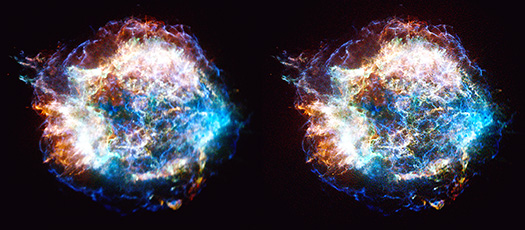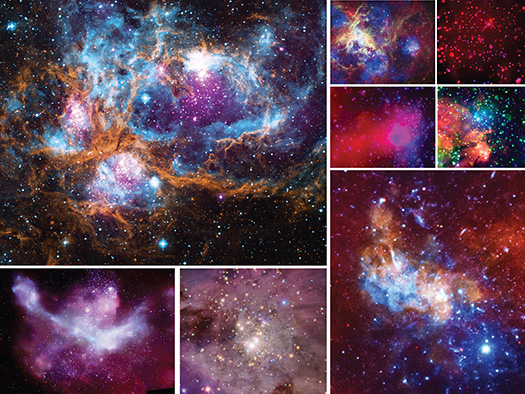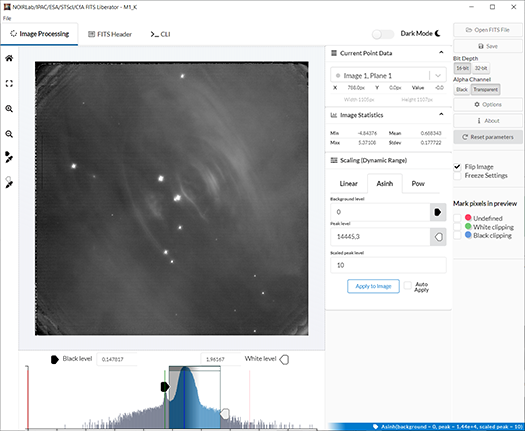A Fab Five: New Images With NASA's Chandra X-ray Observatory
Submitted by chandra on Tue, 2023-09-12 16:32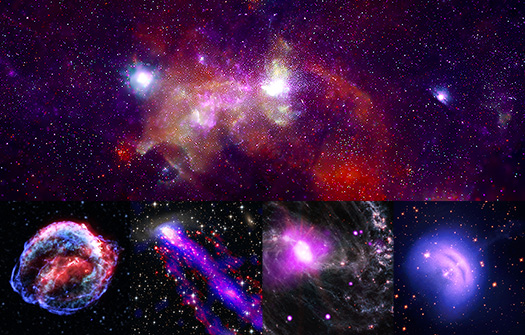
A new collection of stunning images highlights data from NASA’s Chandra X-ray Observatory and other telescopes.
Credit: NASA/CXC/SAO, JPL-Caltech, MSFC, STScI, ESA/CSA, SDSS, ESO
A new collection of stunning images highlights data from NASA’s Chandra X-ray Observatory and other telescopes. These objects have been observed in light invisible to human eyes — including X-rays, infrared, and radio — by some of the world’s most powerful telescopes. The data from different types of light has been assigned colors that the human eye can perceive, allowing us to explore these cosmic entities.
The objects in this quintet of images range both in distance and category. Vela and Kepler are the remains of exploded stars within our own Milky Way galaxy, the center of which can be seen in the top panorama. In NGC 1365, we see a double-barred spiral galaxy located about 60 million light-years from Earth. Farther away and on an even larger scale, ESO 137-001 shows what happens when a galaxy hurtles through space and leaves a wake behind it.
Welcoming a New Member of the X-ray Family
Submitted by chandra on Fri, 2023-08-25 10:27
Artist's concept of the XRISM (X-ray Imaging and Spectroscopy Mission) spacecraft.
Credit: NASA's Goddard Space Flight Center Conceptual Image Lab
On September 6th, a new X-ray telescope was launched into space, joining the Chandra X-ray Observatory, XMM-Newton, and others already exploring the high-energy Universe.
The X-ray Imaging and Spectroscopy Mission (XRISM, pronounced “crism”) is led by the Japanese Aerospace Exploration Agency, or JAXA, with contributions from NASA and the European Space Agency.
What will scientists use XRISM for? This feature from NASA describes some of what is can do and the embedded video does an excellent job explaining why ‘spectroscopy’ is so important to astronomers and their study of the Universe.
https://www.nasa.gov/feature/feature/2023/xrism-spacecraft-will-open-new...
New Technique Improves Clarity of Chandra Images
Submitted by chandra on Tue, 2023-06-27 13:59A team of researchers has announced the development of a new way to process X-ray data from NASA’s Chandra X-ray Observatory. This technique will improve the clarity, or sharpness, of some Chandra’s images, including the Cassiopeia A supernova remnant. According to a press release from Rikkyo University in Japan, this new method corrects for the differences in focusing power in different parts of Chandra's images, and could “lead to improved measurement accuracy and the discovery of unknown structures.”
Cosmic Harmonies: Sonifications From NASA Telescopes
Submitted by chandra on Thu, 2023-06-15 16:04Astronomers often look at objects in space through multiple telescopes. Because different telescopes can detect different types of light, each brings its own pieces of information to whatever is being observed. This is similar in some ways to how different notes of the musical scale can be played together to create harmonies that are impossible with single notes alone.
In the past few years, NASA has been producing “sonifications” of astronomical data of objects in space. This project takes the digital data captured by its telescopes in space — most of which is invisible to our unaided eyes — and translates them into musical notes and sounds so they can be heard rather than seen. Each layer of sound in these sonifications represents particular wavelengths of light detected by NASA’s Chandra X-ray Observatory, James Webb Space Telescope, Hubble Space Telescope, and Spitzer Space Telescope in various combinations.
The Enduring and Engaging Legacy of Leisa Townsley
Submitted by chandra on Thu, 2023-01-05 10:29When Dr. Leisa Townsley passed away this summer, the scientific community lost a brilliant researcher, teacher, and mentor. She was all of those things, but we wanted to feature some of the pivotal and critical ways that she helped the Chandra X-ray Observatory, specifically our Communications and Public Engagement work.
Chandra was launched into space in 1999 and with the beginning of its successful operations, a new era in high-energy astrophysics was born. For certain deep space objects that emitted enough X-ray photons, Chandra brought, for the first time, the ability to create richly detailed, high-resolution images. These X-ray images, however, were different in many ways from the images of its previously-launched sister Great Observatory, the Hubble Space Telescope.
Establishing a visual identity for Chandra, both on its own and in collaboration with other telescopes that study different kinds of light, including Hubble, was no small challenge. Our Chandra group was responsible for finding the best way to show X-ray data, which often looks completely different from optical data. Would traditional techniques used for visible light data be suitable to process X-ray data? Would new processes and tactics need to be developed to make X-ray data more accessible, easier to understand and process?
50 Years Ago, NASA’s Copernicus Set the Bar for Space Astronomy
Submitted by chandra on Mon, 2022-08-22 11:58This vintage segment on Copernicus comes from a 1973 edition of “The Science Report,” a long-running film series produced by the U.S. Information Agency. Credit: National Archives (306-SR-138B)
The following blog post is a special feature on the history of astrophysics and space science written by Francis Reddy, a public affairs specialist at NASA’s Goddard Space Flight Center. There is a brief summary of how X-ray astronomy, including the Chandra X-ray Observatory, and practically every other branch of astrophysics benefited from humanity’s success at launching objects into orbit. The original post is available on the NASA portal.
At 6:28 a.m. EDT on Aug. 21, 1972, NASA’s Copernicus satellite, the heaviest and most complex space telescope of its time, lit up the sky as it ascended into orbit from Launch Complex 36B at Cape Canaveral Air Force Station, Florida.
Initially known as Orbiting Astronomical Observatory (OAO) C, it became OAO 3 once in orbit in the fashion of the time. But it was also renamed to honor the upcoming 500th anniversary of the birth of Nicolaus Copernicus (1473 – 1543). The Polish astronomer formulated a model of the solar system with the Sun in the central position instead of Earth, breaking with 1,300 years of tradition and triggering a scientific revolution.
Belinda Wilkes Named Lifetime AAAS Fellow
Submitted by chandra on Wed, 2022-02-02 08:24
Belinda J. Wilkes
Credit: Center for Astrophysics | Harvard & Smithsonian
The American Association for the Advancement of Science (AAAS), the world's largest general scientific society, has elected Belinda J. Wilkes from the Center for Astrophysics | Harvard & Smithsonian to its newest class of AAAS Fellows.
The 2021 class of AAAS Fellows includes 564 scientists, engineers and innovators spanning 24 scientific disciplines who are recognized for their scientifically and socially distinguished achievements.
"We are incredibly proud of Belinda and her contributions to the field of astronomy," says Mike McCarthy, deputy director of the Center for Astrophysics. "This is one of the most distinct honors a scientist can achieve."
Wilkes is a senior astrophysicist at the Center for Astrophysics who served as director of the Chandra X-Ray Center (CXC) from 2014-2020. There she oversaw science and flight operations of the Chandra X-ray Observatory, one of NASA's flagship space-based telescopes.
Why Make Sonifications of Astronomical Data?
Submitted by chandra on Tue, 2021-09-14 11:39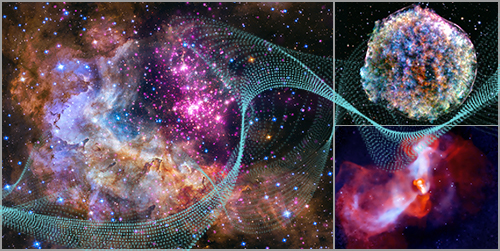
Jingle, Pluck, and Hum: Sounds from Space
Credit: NASA/CXC/SAO/K.Arcand, SYSTEM Sounds (M. Russo, A. Santaguida)
When you travel to a foreign country where they speak a language you do not understand, it is usually imperative that you find a way to translate what is being communicated to you. In some respects, the same can be said about data collected from objects in space.
A telescope like NASA's Chandra X-ray Observatory captures X-rays, which are invisible to the human eye, from sources across the cosmos. This high-energy light gets sent back down to Earth in the form of ones and zeroes. From there, the data are transformed into a variety of different things — from plots to spectra to images.
This last category — images — is arguably what most telescopes are best known for. For most of astronomy's long history, however, most who are blind or visually impaired (BVI) can often not fully experience the wonders that telescopes have captured.
In recent decades, that has begun to change. There are various ways that astronomers, data scientists, astronomy communication professionals, and others can work with communities of different abilities, from creating 3D prints and visual descriptions to sound-based products. As part of the Chandra X-ray Center and NASA's Universe of Learning, a team of experts led by Dr. Kimberly Arcand has been working to "sonify" (turn into sound) data from some of NASA's greatest telescopes.
Upgrading Our Views of the Universe
Submitted by chandra on Thu, 2021-03-18 14:44How do we image our Universe? There are many different ways of translating information from the cosmos. But in working with scientific data and image processing software, you can create your own astronomy images from FITS files. "FITS," which stands for Flexible Image Transport System, is a digital file format used mainly by astronomers to work with data of cosmic objects. Today, we are happy to help announce an update to the open source FITS Liberator software that can be used to process your own astronomical data. —Kimberly Kowal Arcand (CfA)
Astronomy is predominantly a visual science. However, an important tool is needed to produce breathtaking color images from the observations made with telescopes such as the NASA/ESA Hubble Space Telescope, NASA's Chandra X-ray Observatory, or the telescopes of NSF's NOIRLab at the international Gemini Observatory, Kitt Peak National Observatory, and Cerro Tololo Inter-American Observatory. The key to unlocking those magnificent vistas is specialized image-processing software.
Data Sonification: A New Cosmic Triad of Sound
Submitted by chandra on Fri, 2020-11-20 14:58Sonification Credit: NASA/CXC/SAO/K. Arcand, SYSTEM Sounds (M. Russo, A. Santaguida)
A new trio of examples of 'data sonification' from NASA missions provides a new method to enjoy an arrangement of cosmic objects. Data sonification translates information collected by various NASA missions — such as the Chandra X-ray Observatory, Hubble Space Telescope, and Spitzer Space Telescope — into sounds.
This image of the Bullet Cluster (officially known as 1E 0657-56) provided the first direct proof of dark matter, the mysterious unseen substance that makes up the vast majority of matter in the Universe. X-rays from Chandra (pink) show where the hot gas in two merging galaxy clusters has been wrenched away from dark matter, seen through a process known as "gravitational lensing" in data from Hubble (blue) and ground-based telescopes. In converting this into sound, the data pan left to right, and each layer of data was limited to a specific frequency range. Data showing dark matter are represented by the lowest frequencies, while X-rays are assigned to the highest frequencies. The galaxies in the image revealed by Hubble data, many of which are in the cluster, are in mid-range frequencies. Then, within each layer, the pitch is set to increase from the bottom of the image to the top so that objects towards the top produce higher tones.
Pages
Please note this is a moderated blog. No pornography, spam, profanity or discriminatory remarks are allowed. No personal attacks are allowed. Users should stay on topic to keep it relevant for the readers.
Read the privacy statement

